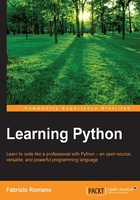
Guidelines on how to write good code
Writing good code is not as easy as it seems. As I already said before, good code exposes a long list of qualities that is quite hard to put together. Writing good code is, to some extent, an art. Regardless of where on the path you will be happy to settle, there is something that you can embrace which will make your code instantly better: PEP8.
According to Wikipedia:
"Python's development is conducted largely through the Python Enhancement Proposal (PEP) process. The PEP process is the primary mechanism for proposing major new features, for collecting community input on an issue, and for documenting the design decisions that have gone into Python."
Among all the PEPs, probably the most famous one is PEP8. It lays out a simple but effective set of guidelines to define Python aesthetic so that we write beautiful Python code. If you take one suggestion out of this chapter, please let it be this: use it. Embrace it. You will thank me later.
Coding today is no longer a check-in/check-out business. Rather, it's more of a social effort. Several developers collaborate to a piece of code through tools like git and mercurial, and the result is code that is fathered by many different hands.
Note
Git and Mercurial are probably the most used distributed revision control systems today. They are essential tools designed to help teams of developers collaborate on the same software.
These days, more than ever, we need to have a consistent way of writing code, so that readability is maximized. When all developers of a company abide with PEP8, it's not uncommon for any of them landing on a piece of code to think they wrote it themselves. It actually happens to me all the time (I always forget the code I write).
This has a tremendous advantage: when you read code that you could have written yourself, you read it easily. Without a convention, every coder would structure the code the way they like most, or simply the way they were taught or are used to, and this would mean having to interpret every line according to someone else's style. It would mean having to lose much more time just trying to understand it. Thanks to PEP8, we can avoid this. I'm such a fan of it that I won't sign off a code review if the code doesn't respect it. So please take the time to study it, it's very important.
In the examples of this book, I will try to respect it as much as I can. Unfortunately, I don't have the luxury of 79 characters (which is the maximum line length suggested by PEP*), and I will have to cut down on blank lines and other things, but I promise you I'll try to layout my code so that it's as readable as possible.